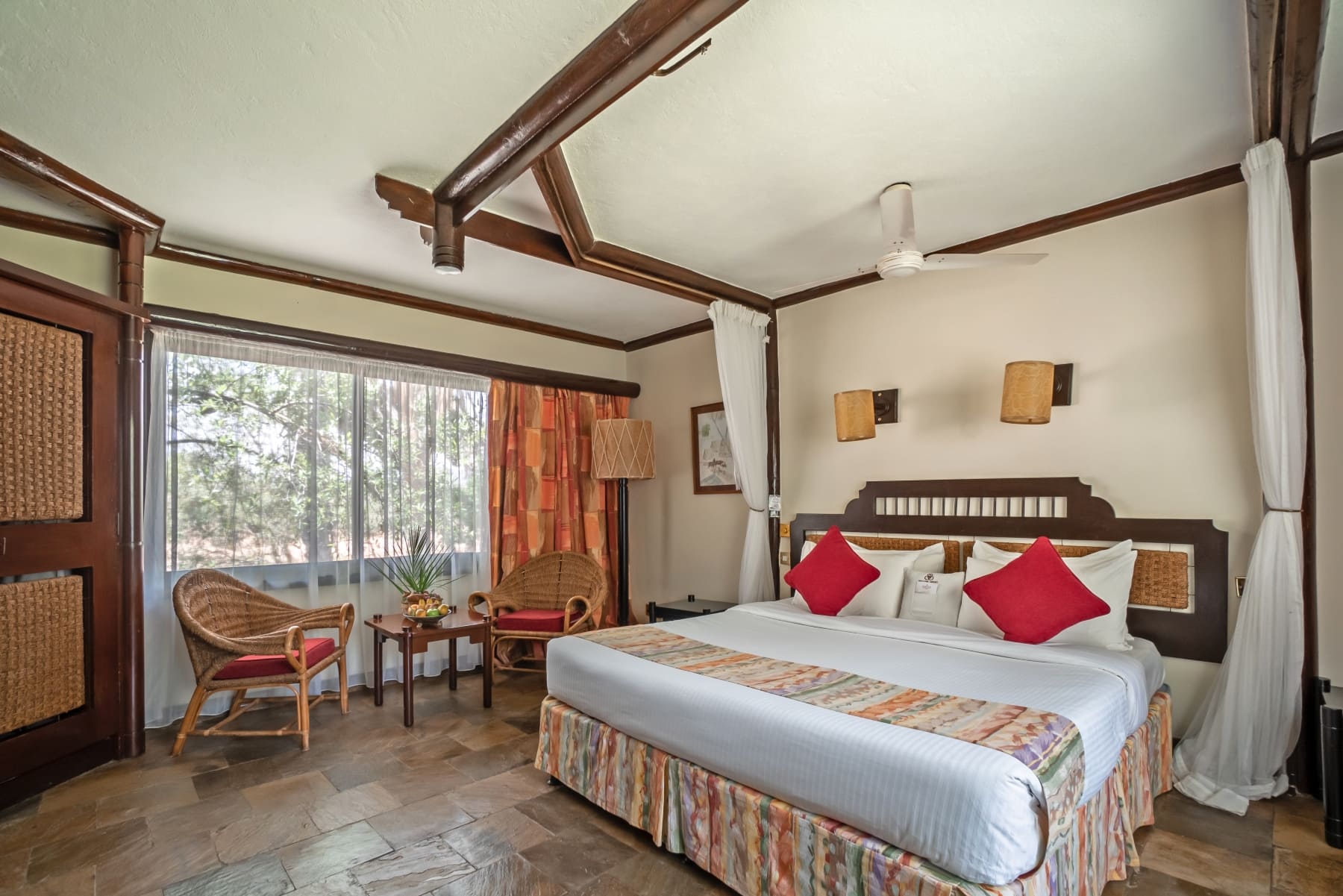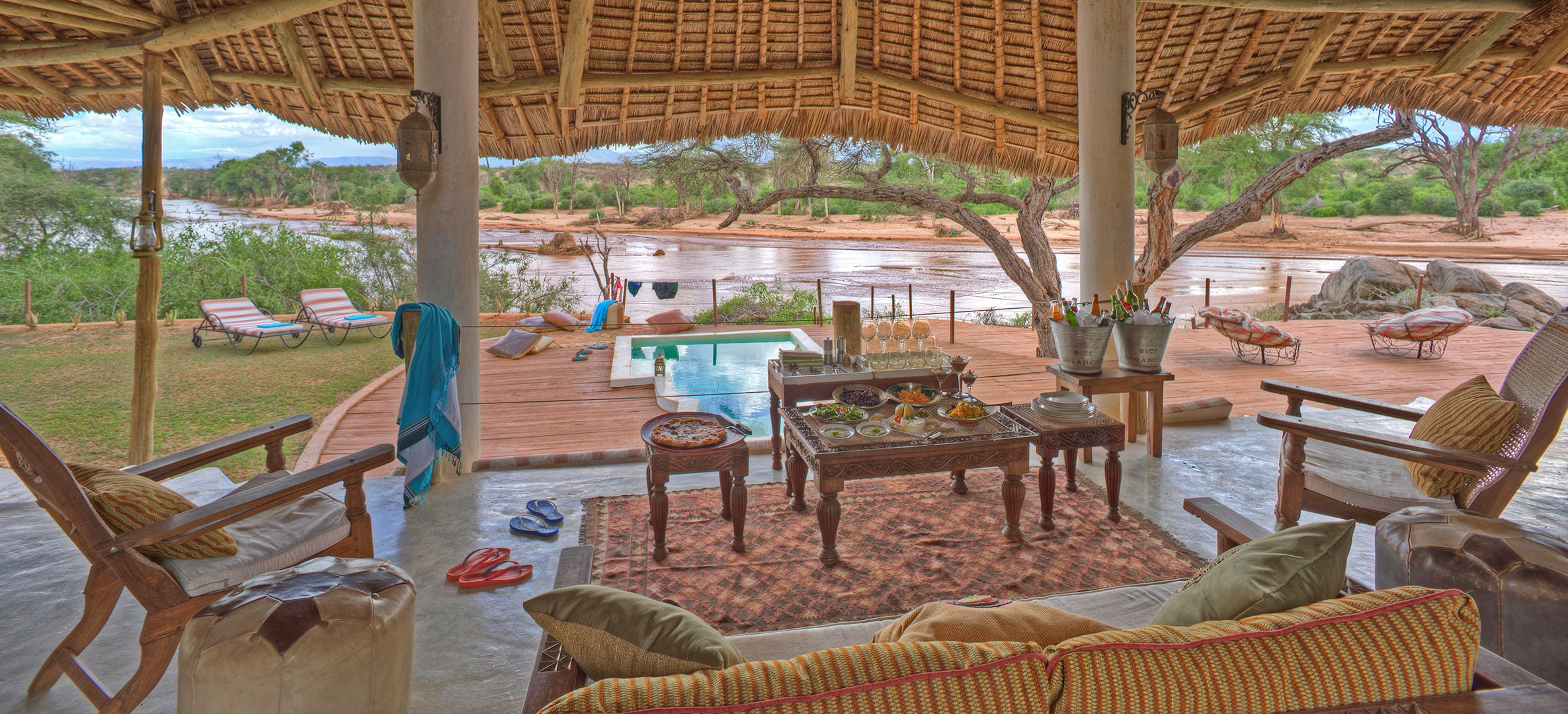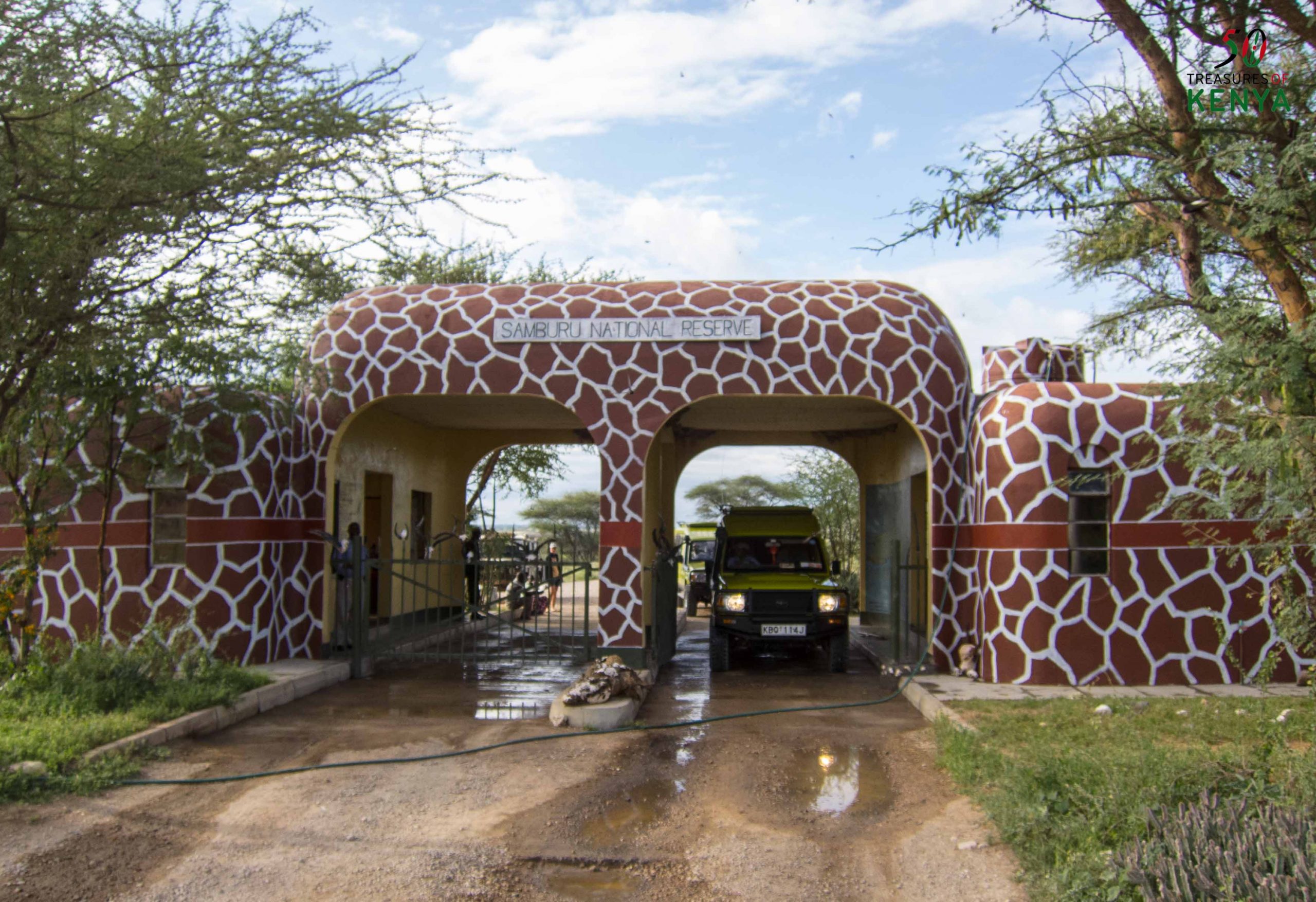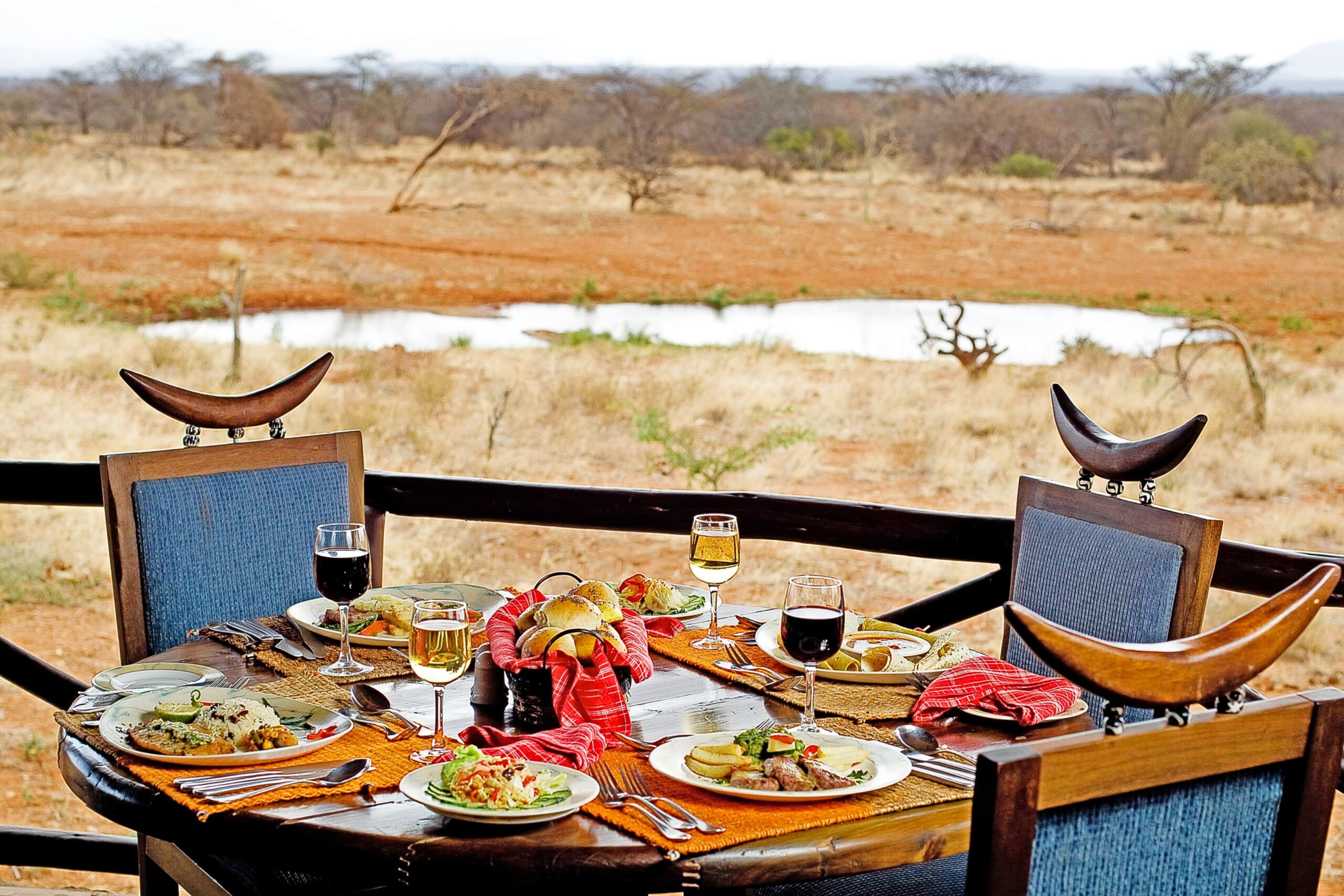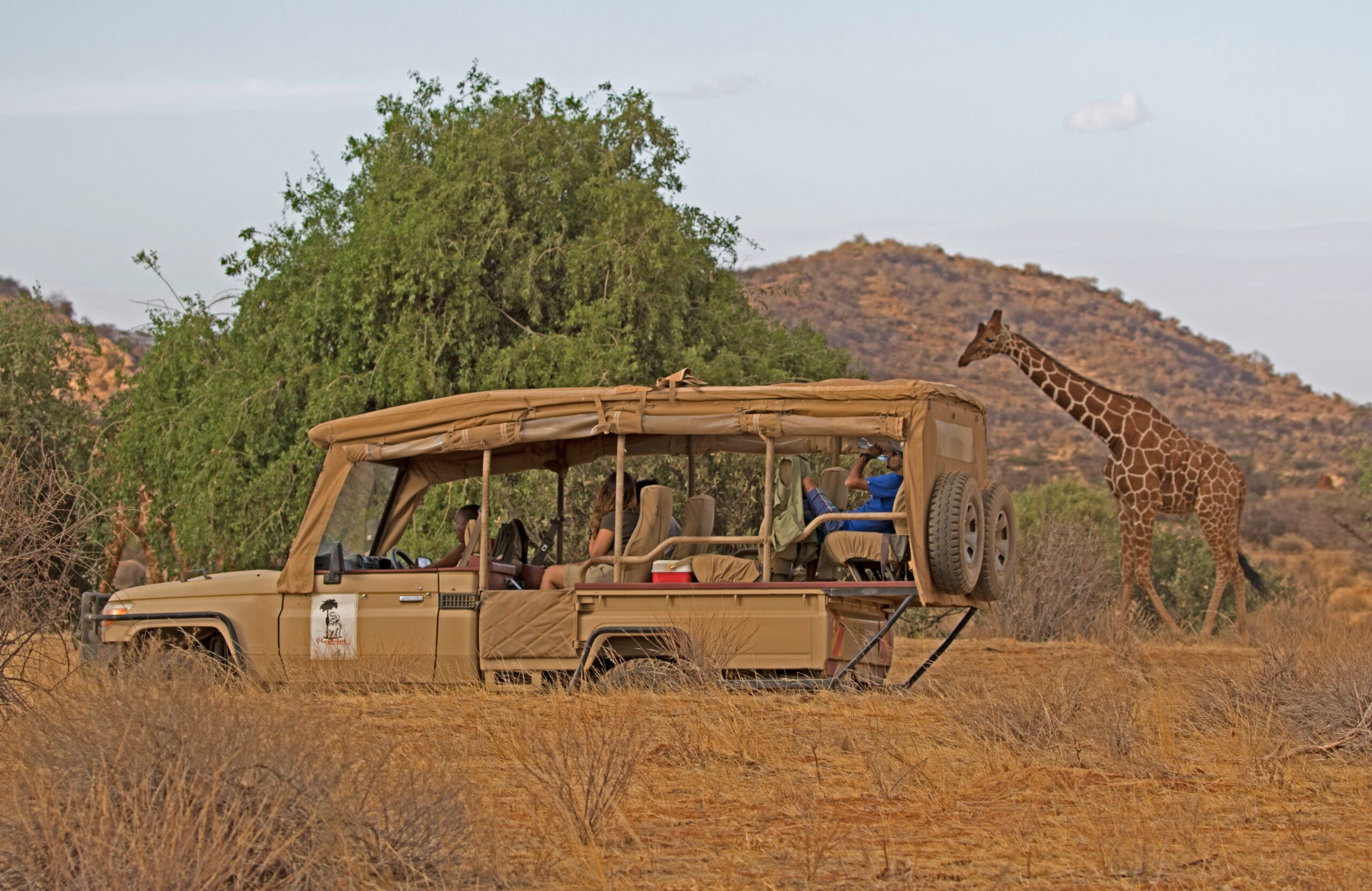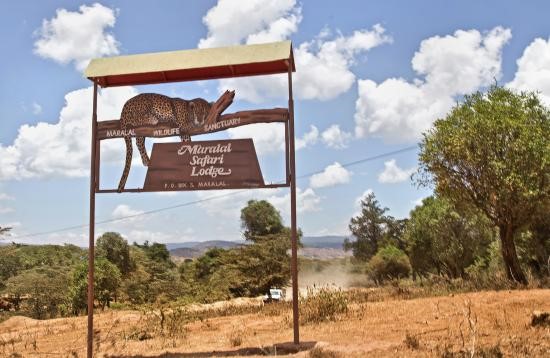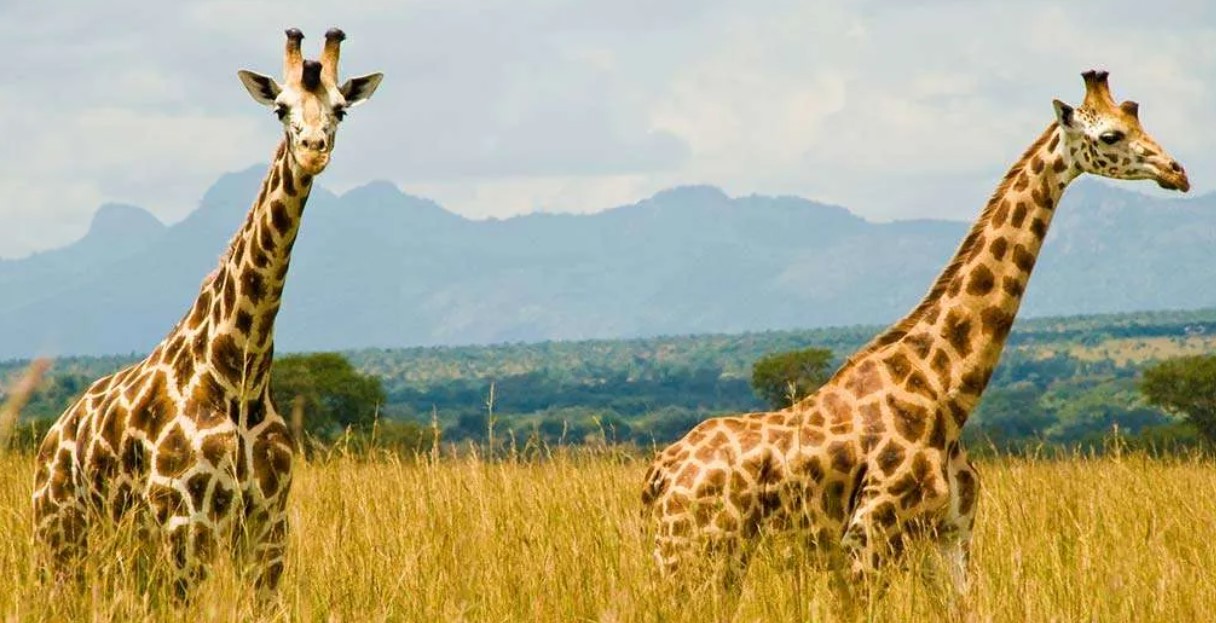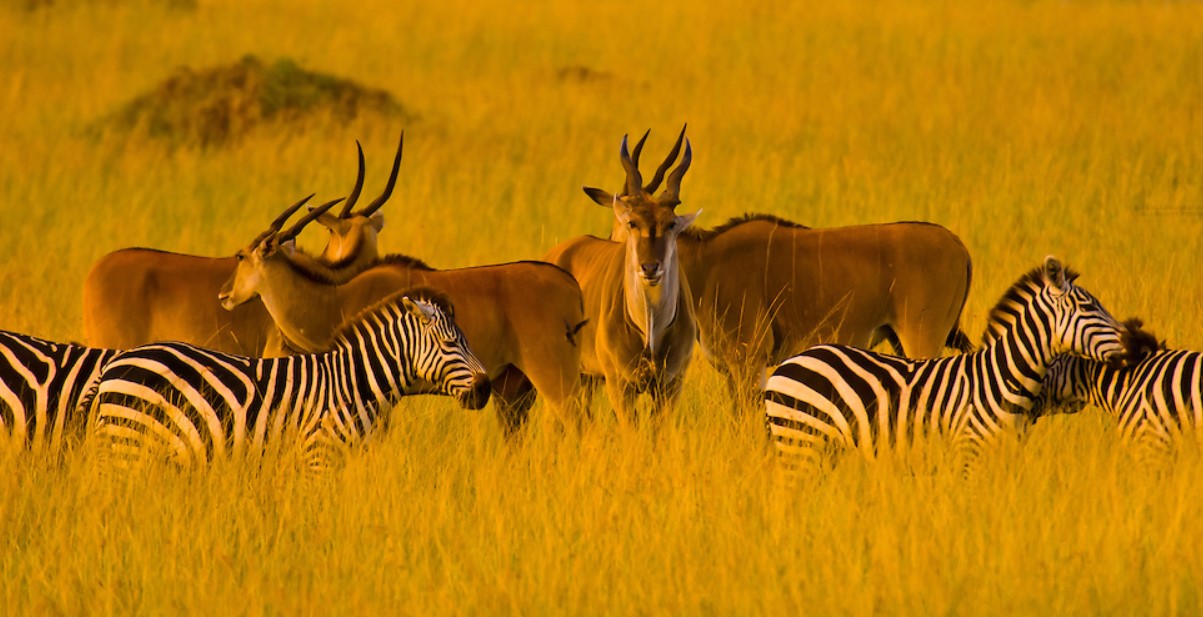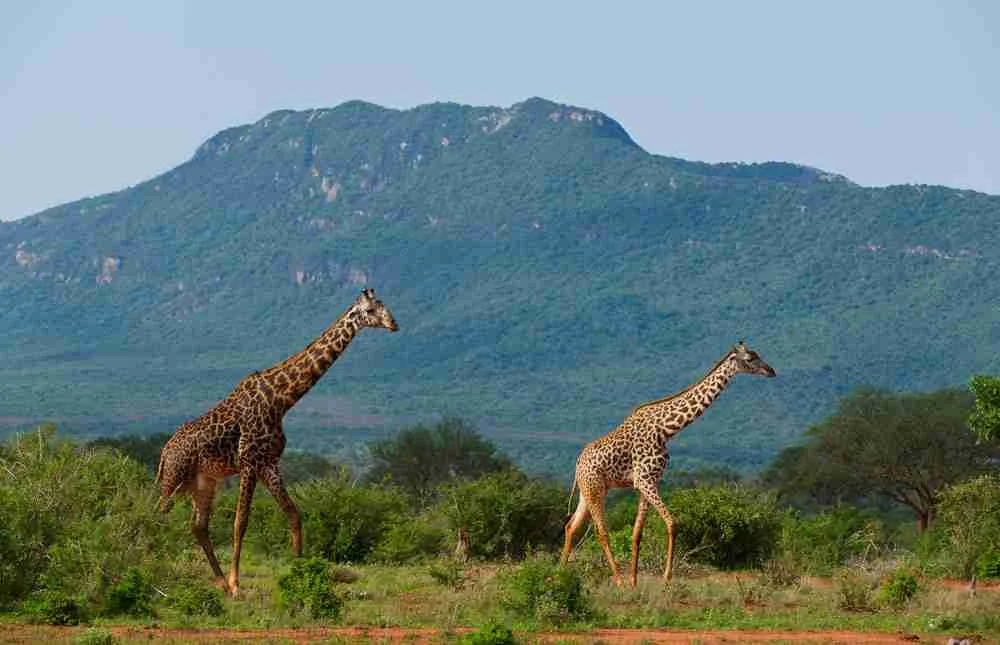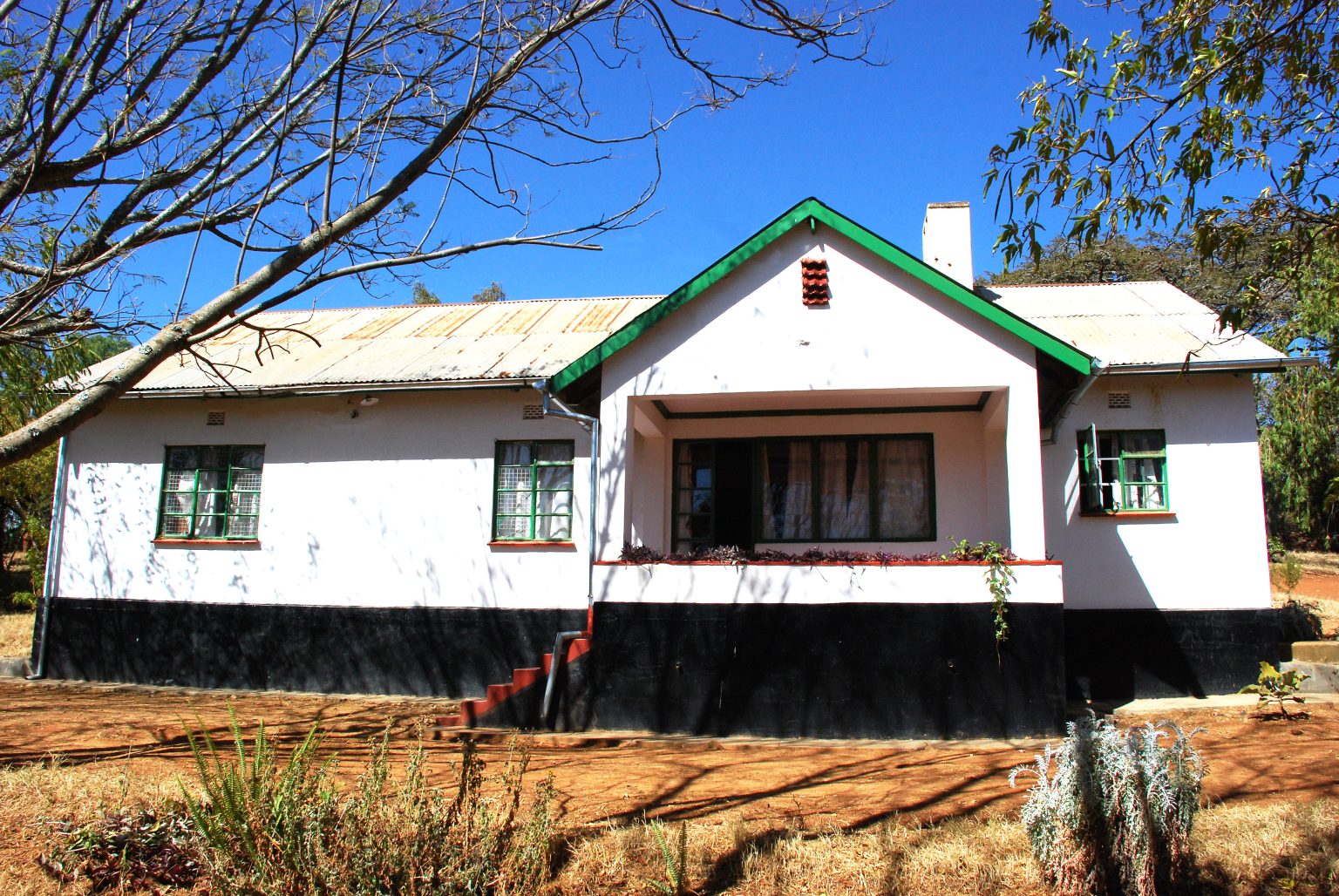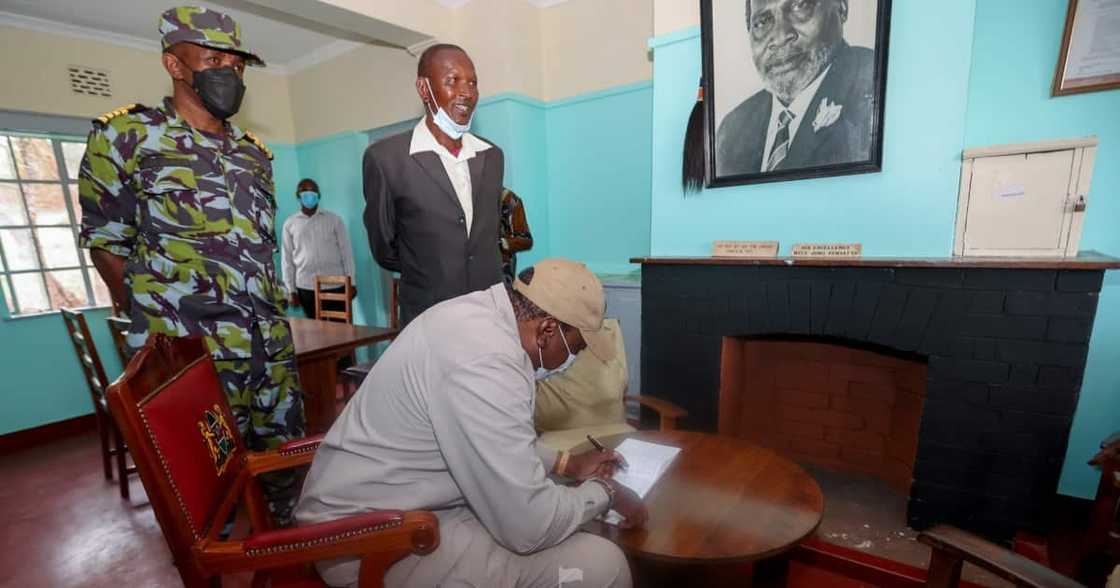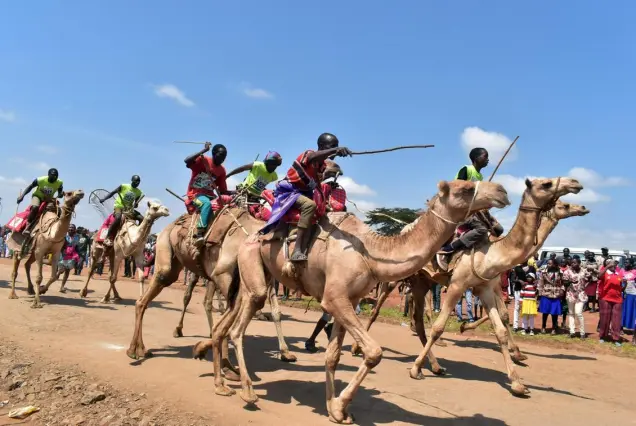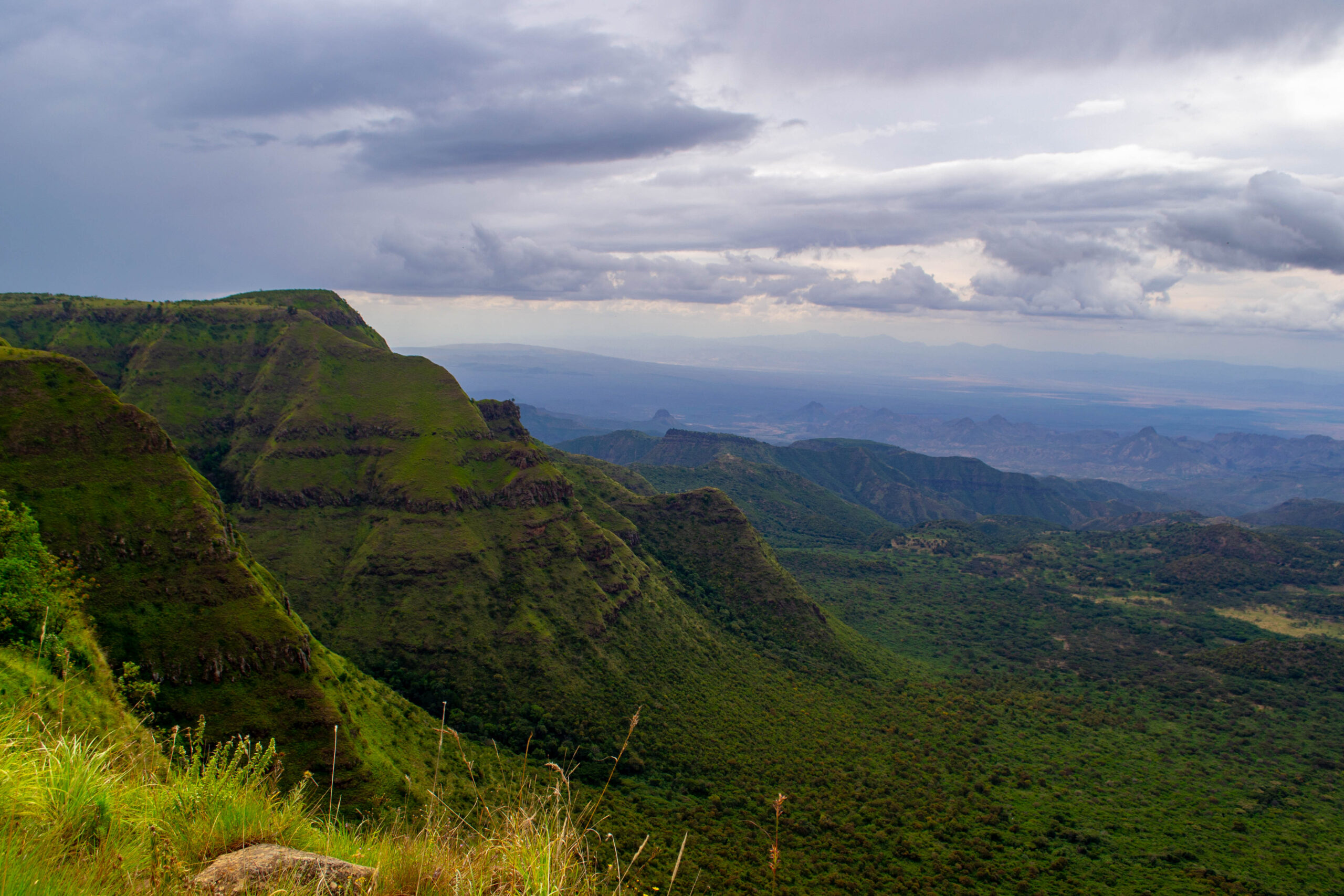Place to Visit in Samburu
The County of Samburu boasts a large number of exceptional sites and attractions which are found in all parts of the County.
Samburu National Reserve
The most famous and most visited attraction of Samburu Land is Samburu National Reserve on the northern banks of Ewaso Nyiro river, a unique natural gem covering 165 sqkm, which makes it neither Kenya’s nor the County’s largest nature reserve. But wildlife variety and density is amongst the highest in the country, possibly second only to the Masai Mara. It is especially known for high elephant numbers and the rare dryland fauna of northern Kenya, the ‘Samburu Five’ comprising of Beisa oryx, Somali ostrich, reticulated giraffe, gerenuk and Grevy’s zebra. All in all, there are 50 species of larger mammals identified in Samburu National Reserve, amongst them the great cats lion, leopard and cheetah, as well as impala, greater and lesser kudu and a prolific birdlife, of which hornbill, vulturine Guinea fowl, weaver birds and various birds of prey are the most conspicuous. Samburu National Reserve’s scenic landscape is an experience in its own, combining undulating landscapes of doum palm fringed river banks, bold rocky outcrops and vast grassland savannah with acacia trees.
Within the Reserve and at its fringes, there are wonderfully set lodges and safari camps. Not surprisingly, Samburu National Reserve boasts the best tourist infrastructure of all conservation areas in northern Kenya and guarantees its visitors an unforgettable safari experience.
Access
The road network inside Samburu National Reserve is in good to decent condition. On the major route through the park, washboard ripples and speeding are an issue.
There are five gates to enter Samburu National Reserve: Archer’s Gate, which is the main gate near Archer’s Post, just a few kilometres off the Marsabit highway; West Gate at the western border of the reserve with West Gate Community Conservancy; Kalama Gate in the north at the border with Kalama Community Conservancy; and Waso Bridge Gate, which is used when crossing the Ewaso Nyiro bridge coming from Buffalo Springs National Reserve, that lies opposite Samburu National Reserve on the southern banks of Ewaso Nyiro river in Isiolo County. When arriving by air, you find gate services at the central air strip. The airstrip is served daily to/from Nairobi by Air Kenya and Safarilink.
Accommodation
The most prominent and comfortable accommodation inside Samburu National Reserve offer Samburu Game Lodge, Larsen’s Camp, Samburu Sopa Lodge, Samburu Intrepids, Elephant Bedroom Camp, Elephant Watch Safaris Camp and Miiba Mingi Tented Lodge.
Those preferring to use own tents find a wide range of public campsites (near Samburu Game Lodge, Butterfly, Vervet and Jua kali campsite) and special campsites (Kimpla Geo, Aardvark and Grant campsite) inside of Samburu National Reserve.
Maralal Wildlife Sanctuary
About 1.5 kilometres from the centre of town lies the Maralal Wildlife Sanctuary, a conservation area of 5sqm covering the rocks and plains to the southwest of Maralal. The Sanctuary has been put under legal protection at the beginning of the last century as it sits at the intersection of a famous wildlife corridor. It surely constitutes the potentially biggest tourist attraction of Maralal. Only two other major Kenyan cities, Nairobi and Nakuru with their world famous national parks, boast a comparable jewel in their immediate vicinity, and the unfenced Sanctuary is one of only two of its kind in the whole of Kenya.
Wildlife in Maralal Wildlife Sanctuary ranges from the elusive aardvarks and zorillas and extends to the exciting leopards and hyenas. Among the other creatures you will find warthogs, jackals, zebras (sometimes even the rare Grevy’s zebra!), hyrax, giant leopard tortoises, genets, impala, monkeys, baboons, rock hoppers, elands. And eventually, even elephants do pass through on their way from Mugie conservancy to the forests of Kirisia hills. Ornithologist can trace two hundred species of birds, with the White Bellied Go Away Bird being a favourite.
Apart from the freely roaming animals, there is an animal orphanage for orphaned or injured animals with changing residents who are re-introduced to the wild whenever possible. The orphanage has responded to an urgent need for wildlife welfare, as the next such institution is found in Nairobi, but it also adds to the attraction of the Sanctuary. The management of the lodge and the sanctuary offers the opportunity to volunteer alongside their professionals at the animal orphanage. In general, animals can be seen at an incredible close range in the Maralal Wildlife Sanctuary. The reserve can be explored on a walking safari with one of the resident rangers, and to approach the wild creatures on foot surely is an unforgettable experience. In the heart of the conservation area lies the Maralal Safari Lodge, one of the best hotels in Maralal. Guests having a meal at the lodge or are even staying there can watch plenty of animals at the watering whole just a couple of metres in front of the terrace. Animals do even come right up to the guest rooms. Zebras mingle among the guest cabins and the monkeys scamper overhead.
West Gate Conservancy
West Gate Conservancy stretches along Ewaso Nyiro river to the west of Samburu National Reserve – hence its name. Its landscape is dominated by acacia scrubland dotted with rocky outcrops and a green ribbon of riparian plant growth along the Ewaso Nyiro. The scenery might be not exactly as charming and varied as that of the National Reserve, yet it is a perfect spot for wildlife encounters and will thrill those travellers who are looking for a more private experience of the African bush and at the same time want to get a deep insight into the lifestyle of the local Samburu people.
Measuring 400 sqkm, Westgate is a safe haven for up to 500 heads of the rare Grevy’s zebra (hence the West Gate Conservancy’s moto “We cherish to Conserve – The Grevvy zebra is our Gold”), numerous elephants, lesser kudu, Somali ostrich, Grant’s gazelle, impala, warthog and waterbuck. Being sandwiched between the Ewaso Nyiro in the south, Meibae Conservancy to the west and Kalama Conservancy, respectively Samburu National Reserve to the east, West Gate’s ecological role as an important wildlife corridor for animals moving between the river and the conservancies further to the north can’t be overestimated.
Founded only in 2004, the Conservancy has reached impressive achievements by establishing anti- poaching units which in return have boosted security and wildlife numbers, apart from creating jobs for community rangers. Another benefit achieved by the Conservancy is an advanced grazing management program, that enables the rehabilitation of degraded soils and the sustainable utilization of the land by both, higher livestock and wildlife numbers. Almost twenty women groups were trained in craft-making, product development, basic accounting and leadership skills and there is also a micro-credit program that enables the owners of the group ranch to set up alternative sources of incomes for their families. A cattle sale program has proven equally successful, earning the pastoralist families much needed cash.
Apart from the Northern Rangeland Trust, West Gate is closely partnering with Ewaso Lions, a community based organisation who works to conserve lions and other large carnivores. Although their Warrior Watch program is majorly to increase community engagement in conservation, the warriors also collect important data on wildlife presence, and assist West Gate Conservancy rangers in security operations and wildlife monitoring.
Kenyatta House Maralal
Set off a little way from the centre of Maralal town, surrounded by verdant hills, stands Kenyatta House. The national monument under management of the National Museums of Kenya played its fair bit during Kenya’s independence struggle. It was here that Kenya’s first president, Mzee Jomo Kenyatta, was detained as negotiations of the terms of independence were ongoing. After he had been held for 7 years at Lokitaung in northern Turkana, the pleasant setting of Maralal with a view of Mount Kenya to the south must have been meant as a first concession by the British colonial administration.
Kenyatta House displays interesting exhibits, e.g. historic photographs, the original telephone and furniture of the Kenyatta family. The visitor’s book bears and entry of the current president, the son of Mzee Jomo Kenyatta, Hon. Uhuru Kenyatta, who is said to have been conceived in Kenyatta House during the detention. Kenyatta House is surrounded by a pleasant garden. On clear days you can catch a glimpse of Mount Kenya to the South, hence the title of Jomo Kenyatta’s book ‘Facing Mount Kenya’, which he wrote during his detention in Maralal.
There is another significant historic building in town though it is not of the same importance. Mzee Jomo Kenyatta was not the only prominent freedom fighter held in custody in Maralal. A small building with two cells is still standing in which Paul Ngei was kept when he was detained in Maralal on his way to imprisonment in northern Kenya. It is said that Kenyatta was granted permission and in fact paid Paul Ngei a visit in his cell in 1960 where the two heroes strengthened their bonds.
Maralal International Camel Derby
The town becomes the liveliest on the second weekend of August, when the International Camel Derby comes to town, an annual three day event of excitement, colours and festivities at Yare Camel Camp. Anyone is eligible to enter the derby as an amateur or professional or just to watch, enjoy the pomp and fun as dozens of competitors from as far as South Africa, China, Australia, Japan, Mexico, Spain, America and Europe engage each other in both professional and amateur categories. Each edition of the event is usually marked by a theme. This year was the 26th edition of the Derby and the theme was: “Sporting for Tourism, Conservation and Peaceful Cultural Interaction.”Kenyatta House displays interesting exhibits, e.g. historic photographs, the original telephone and furniture of the Kenyatta family. The visitor’s book bears and entry of the current president, the son of Mzee Jomo Kenyatta, Hon. Uhuru Kenyatta, who is said to have been conceived in Kenyatta House during the detention. Kenyatta House is surrounded by a pleasant garden. On clear days you can catch a glimpse of Mount Kenya to the South, hence the title of Jomo Kenyatta’s book ‘Facing Mount Kenya’, which he wrote during his detention in Maralal.
There is another significant historic building in town though it is not of the same importance. Mzee Jomo Kenyatta was not the only prominent freedom fighter held in custody in Maralal. A small building with two cells is still standing in which Paul Ngei was kept when he was detained in Maralal on his way to imprisonment in northern Kenya. It is said that Kenyatta was granted permission and in fact paid Paul Ngei a visit in his cell in 1960 where the two heroes strengthened their bonds.
The Malaso/World End Viewpoint
A one-and-a-half hour drive from Maralal, through beautiful forest stretches and extensive wheat farms, one of Samburu Land’s top attractions is to be reached. Just some 15 kilometres off the Maralal Baragoi road, the Kirisia Hills are plunging into the Suguta Valley, creating the Malaso or World’s End Viewpoint. From the viewpoint, visitors enjoy a spectacular panoramic view over the steep dropoff into and across the Northern Rift Valley, up to the Cherangani Hills on the far western side of the depression. Sunsets are just stunning and the place is a paradise for landscape photographers, bird watchers and hikers. The local Samburu community who owns the land and turned it into a conservancy, offers guided walks along the breathtaking cliffs and down to the valley floor. The twohour-descend is especially worthwhile on Saturdays, when there is a traditional market being held where Pokot and Samburu trade agricultural produce and animals. On request, the community does also organise cave excursions, traditional dance performances, village visits, cultural talks with elders over bonfire and cow darting.
Kenyatta House displays interesting exhibits, e.g. historic photographs, the original telephone and furniture of the Kenyatta family. The visitor’s book bears and entry of the current president, the son of Mzee Jomo Kenyatta, Hon. Uhuru Kenyatta, who is said to have been conceived in Kenyatta House during the detention. Kenyatta House is surrounded by a pleasant garden. On clear days you can catch a glimpse of Mount Kenya to the South, hence the title of Jomo Kenyatta’s book ‘Facing Mount Kenya’, which he wrote during his detention in Maralal.
There is another significant historic building in town though it is not of the same importance. Mzee Jomo Kenyatta was not the only prominent freedom fighter held in custody in Maralal. A small building with two cells is still standing in which Paul Ngei was kept when he was detained in Maralal on his way to imprisonment in northern Kenya. It is said that Kenyatta was granted permission and in fact paid Paul Ngei a visit in his cell in 1960 where the two heroes strengthened their bonds.
There is another significant historic building in town though it is not of the same importance. Mzee Jomo Kenyatta was not the only prominent freedom fighter held in custody in Maralal. A small building with two cells is still standing in which Paul Ngei was kept when he was detained in Maralal on his way to imprisonment in northern Kenya. It is said that Kenyatta was granted permission and in fact paid Paul Ngei a visit in his cell in 1960 where the two heroes strengthened their bonds.
Maralal Town
Maralal, the capital of Samburu County, lies in the centre of Samburu sub-county. Its setting in the foothills of the Kirisia Hills, at the deepest point of a mountain bay that opens towards Laikipia plains and Mount Kenya to the south, is picturesque. Nevertheless, Maralal lies surprisingly high, at around 2,000 metres above sea level and gets quite chilly at night. In the early mornings, the town is often wrapped in fog, which makes the view from the surrounding hills to Maralal a mystic one.
Maralal is a thriving administrative and trading town which saw a lot of development since devolution took off and local government picked up work in 2012. The picturesque heart of town is formed by two roads lined with beautiful alley trees and long rows of colourful traditional shops. Tourism infrastructure in Maralal is decent, with several good hotels and many proper guesthouses, cheap eateries, bars, petrol stations, banks, workshops and public buses and matatus connecting the town with Nyahururu and Nairobi further south.
For those travellers who are planning to go further north, this is the best place to stock up supplies of water, food, petrol, and chewing tobacco, a present which is well received by elder women and men all over Samburu Land. Those who want to go on a donkey or camel trek through the hills or into Suguta Valley, or plan to continue north by public means of transport, are likely to get everything organized from here.
However, Maralal isn’t merely a logistic point-of-call on the way through, but visitors are recommended to save at least one day to explore the specific charm and noteworthy attractions of the capital of Samburu.
Kenyatta House displays interesting exhibits, e.g. historic photographs, the original telephone and furniture of the Kenyatta family. The visitor’s book bears and entry of the current president, the son of Mzee Jomo Kenyatta, Hon. Uhuru Kenyatta, who is said to have been conceived in Kenyatta House during the detention. Kenyatta House is surrounded by a pleasant garden. On clear days you can catch a glimpse of Mount Kenya to the South, hence the title of Jomo Kenyatta’s book ‘Facing Mount Kenya’, which he wrote during his detention in Maralal.
There is another significant historic building in town though it is not of the same importance. Mzee Jomo Kenyatta was not the only prominent freedom fighter held in custody in Maralal. A small building with two cells is still standing in which Paul Ngei was kept when he was detained in Maralal on his way to imprisonment in northern Kenya. It is said that Kenyatta was granted permission and in fact paid Paul Ngei a visit in his cell in 1960 where the two heroes strengthened their bonds.
There is another significant historic building in town though it is not of the same importance. Mzee Jomo Kenyatta was not the only prominent freedom fighter held in custody in Maralal. A small building with two cells is still standing in which Paul Ngei was kept when he was detained in Maralal on his way to imprisonment in northern Kenya. It is said that Kenyatta was granted permission and in fact paid Paul Ngei a visit in his cell in 1960 where the two heroes strengthened their bonds.


